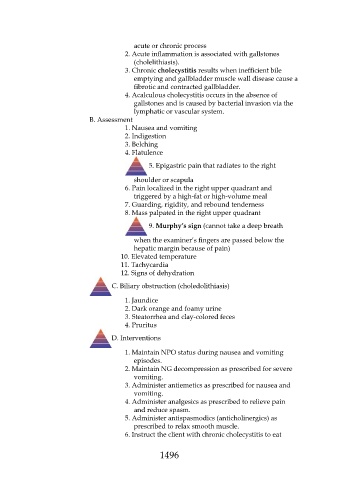Page 1496 - Saunders Comprehensive Review For NCLEX-RN
P. 1496
acute or chronic process
2. Acute inflammation is associated with gallstones
(cholelithiasis).
3. Chronic cholecystitis results when inefficient bile
emptying and gallbladder muscle wall disease cause a
fibrotic and contracted gallbladder.
4. Acalculous cholecystitis occurs in the absence of
gallstones and is caused by bacterial invasion via the
lymphatic or vascular system.
B. Assessment
1. Nausea and vomiting
2. Indigestion
3. Belching
4. Flatulence
5. Epigastric pain that radiates to the right
shoulder or scapula
6. Pain localized in the right upper quadrant and
triggered by a high-fat or high-volume meal
7. Guarding, rigidity, and rebound tenderness
8. Mass palpated in the right upper quadrant
9. Murphy’s sign (cannot take a deep breath
when the examiner’s fingers are passed below the
hepatic margin because of pain)
10. Elevated temperature
11. Tachycardia
12. Signs of dehydration
C. Biliary obstruction (choledolithiasis)
1. Jaundice
2. Dark orange and foamy urine
3. Steatorrhea and clay-colored feces
4. Pruritus
D. Interventions
1. Maintain NPO status during nausea and vomiting
episodes.
2. Maintain NG decompression as prescribed for severe
vomiting.
3. Administer antiemetics as prescribed for nausea and
vomiting.
4. Administer analgesics as prescribed to relieve pain
and reduce spasm.
5. Administer antispasmodics (anticholinergics) as
prescribed to relax smooth muscle.
6. Instruct the client with chronic cholecystitis to eat
1496

